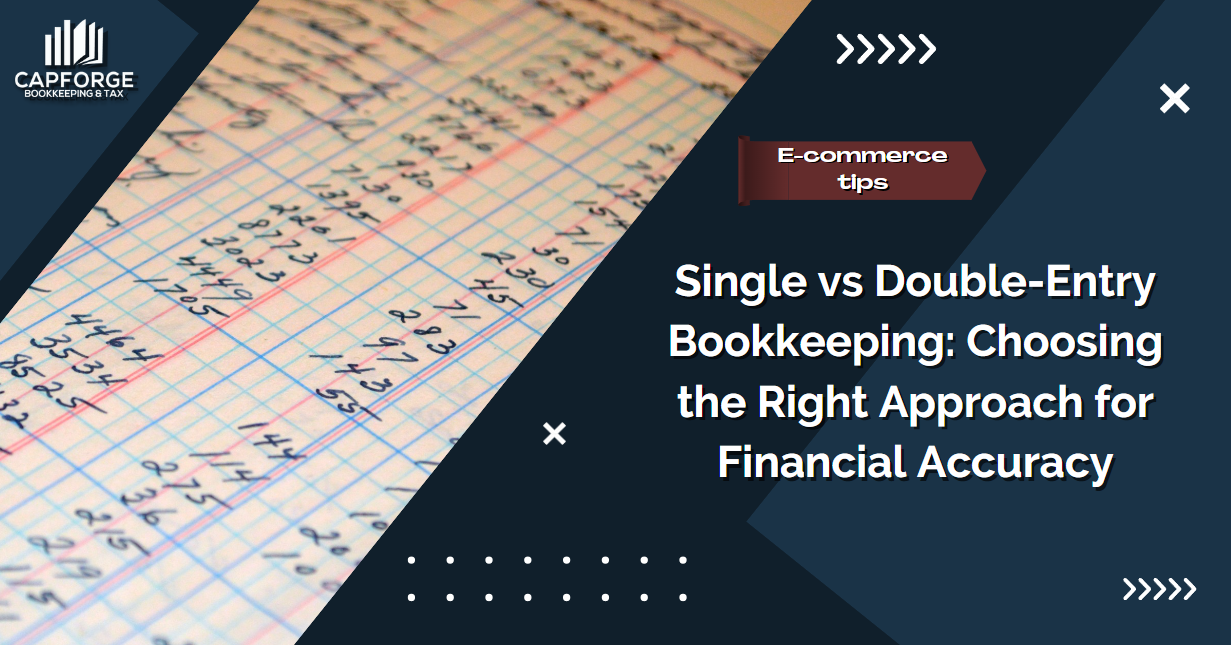Single vs Double-Entry Bookkeeping: Choosing the Right Approach for Financial Accuracy
The importance of bookkeeping extends beyond mere record-keeping; it is a fundamental element that underpins the financial integrity, operational efficiency, and long-term sustainability of businesses and organizations.
When we talk about bookkeeping, there are two primary methods of recording financial transactions; single-entry and double-entry. Both methods have their advantages and drawbacks, and the choice between them often depends on the complexity of the financial transactions and the specific needs of the organization.
In this article, we’ll discuss single vs. double-entry bookkeeping to help you choose the right approach for recording day-to-day transactions.
Understanding Single-Entry Bookkeeping
Single-entry bookkeeping is a straightforward method of bookkeeping that tracks only a single entry for each financial transaction. The process usually looks something like this:
- Basic Recording: Each financial transaction is recorded once, either as an income or an expense, rather than as both a debit and a credit as in double-entry bookkeeping. For example, when a business receives cash from a sale, only the cash received is recorded, without noting the corresponding reduction in inventory or increase in accounts receivable.
- Ledger Maintenance: Transactions are typically recorded in a single ledger, which could be a physical book, a spreadsheet, or even a software application designed for single-entry accounting. Entries might include details such as the date of the transaction, the amount involved, and a brief description.
- Cash Flow Tracking: The primary objective is to keep track of the cash flow, so entries usually focus on bank deposits, withdrawals, sales revenue, and expenses. The ledger provides a running total of cash on hand, offering a snapshot of the business’s liquidity at any given time.
- Income and Expense Tracking: Income is recorded when received, and expenses are recorded when paid. This approach simplifies the process by not requiring the balancing of accounts or the creation of contra accounts, as would be necessary for double-entry bookkeeping.
- Financial Statements: While single-entry bookkeeping does not generate traditional financial statements like a balance sheet or a detailed income statement, it can still provide a basic overview of a business’s financial performance and position. However, the information may be less comprehensive and may not meet the reporting requirements for larger organizations or those subject to regulatory scrutiny.
In a small business context, single-entry bookkeeping can be sufficient for tracking basic income and expenses, recording cash transactions, and monitoring bank account balances. It provides a straightforward way to keep a basic record of financial activities without the complexity of a more comprehensive accounting system.
However, it’s important to note that as a small business grows or its financial transactions become more intricate, the limitations of single-entry bookkeeping may become more pronounced.
For example, single-entry systems can be more susceptible to errors, may not provide a complete picture of the business’s financial health, and can make it more challenging to prepare accurate financial statements or comply with tax regulations.
Exploring Double Entry Bookkeeping
A double-entry bookkeeping system is an advanced method that records each financial transaction in at least two different accounts, thereby providing a more comprehensive and accurate view of a company’s financial position.
In a double-entry system, transactions are recorded in a ledger using debits and credits. Debits are entries that increase assets or decrease liabilities and equity, while credits are entries that decrease assets or increase liabilities and equity.
Here’s how the process works:
- Identifying the Transaction: The first step is to identify and analyze the financial transaction. This involves understanding the nature of the transaction, the accounts affected, and the amount involved.
- Recording the Transaction: Once the transaction is identified, it is recorded in the appropriate journals or subsidiary ledgers. Each transaction is entered using debits and credits, following the principles of double-entry bookkeeping. The debit and credit entries must balance to ensure the equality of the accounting equation.
- Posting to the Ledger: After recording the transaction in the journals, the next step is to post the entries to the general ledger. The ledger contains individual accounts for assets, liabilities, equity, revenue, and expenses. The postings update the balances in these accounts, reflecting the impact of the transaction.
- Balancing the Accounts: Periodically, the balances in the ledger accounts are verified to ensure they match the corresponding account balances in the trial balance. Any discrepancies are investigated and corrected to maintain the integrity of the accounting records.
- Preparing Financial Statements: At the end of the accounting period, the ledger balances are used to prepare financial statements, including the balance sheet, income statement, and cash flow statement. These statements provide a comprehensive view of the company’s financial performance and position.
- Analyzing and Reviewing Financial Data: The financial statements are analyzed to assess the company’s financial health, profitability, and liquidity. This analysis helps stakeholders, such as management, investors, and creditors, make informed decisions and evaluate the company’s performance.
- Closing the Books: At the end of the fiscal year or accounting period, temporary accounts, such as revenue and expense accounts, are closed to retained earnings or equity. This process resets the temporary accounts to zero balances and prepares the books for the next accounting period.
- Auditing and Compliance: Finally, the accounting records and financial statements may be subject to internal or external audits to ensure compliance with accounting standards, regulations, and tax laws. Auditors review the accuracy and completeness of the financial data to assure stakeholders.
The accuracy of double-entry bookkeeping is derived from its systematic approach, dual-entry recording method, built-in checks and balances, detailed transactional recording, and alignment with accounting standards. These features collectively contribute to a more reliable and accurate representation of a company’s financial transactions and position, making double-entry bookkeeping the preferred method for most businesses and accounting professionals.
Are There Any Drawbacks to Using the Single-entry Bookkeeping System?
Single-entry bookkeeping, while simpler than double-entry bookkeeping, comes with several limitations that can impact the accuracy and comprehensiveness of financial records. These are:
1. Prone to errors
One of the primary limitations is the lack of a formal system for ensuring that every transaction is recorded in at least two places, as is the case in double-entry bookkeeping. This absence can lead to errors or omissions, making it challenging to identify and correct mistakes
Without a balanced system to cross-check entries, it becomes more difficult to maintain the integrity of the financial data.
2. Lack of detailed information
Another drawback of single-entry bookkeeping is it lacks the detailed accounts and ledgers that double-entry systems offer. This can be crucial for making informed business decisions and complying with accounting standards.
Such a limitation can hinder the ability to generate comprehensive financial statements, such as balance sheets and income statements, that accurately reflect the organization’s financial position and performance over time.
3. Limited foresight
Sngle-entry bookkeeping may not be suitable for businesses that require more complex financial tracking, such as those with multiple revenue streams, inventory management needs, or intricate expense allocations. The absence of detailed records can make it challenging to analyze trends, forecast future financial outcomes, or prepare for audits effectively.
In essence, while single-entry bookkeeping may be sufficient for very small businesses or sole proprietorships with straightforward financial transactions, it often falls short of meeting the demands of larger or more complex organizations.
How Does Double-Entry Bookkeeping Contribute to Greater Financial Accuracy?
Double-entry bookkeeping uses a balanced approach to keep track of money coming in and going out of a business. Every time money moves, it’s recorded in at least two places, ensuring everything adds up correctly. If there’s a mistake, like an amount being recorded incorrectly, the books won’t balance.
Accountants can then spot this imbalance and trace it back to find where the mistake occurred. Once found, they can make the necessary corrections to ensure the records are accurate again. This system of checks and balances helps catch errors and keeps the financial records reliable.
Implementing a double-entry bookkeeping system involves several key steps to ensure accurate and consistent financial record-keeping. Here’s a simplified guide on how to go about it:
- Choose Accounting Software or Tools: Decide on an accounting software or manual ledger system that supports double-entry bookkeeping. This software will help automate many processes and provide essential features like account reconciliation and financial reporting.
- Set Up Chart of Accounts: Create a chart of accounts that categorizes different types of transactions, such as assets, liabilities, equity, revenue, and expenses. This structure will serve as the foundation for recording financial activities.
- Understand Debits and Credits: Familiarize yourself with the basic principles of debits and credits. In double-entry bookkeeping, every transaction will have both a debit and a credit entry, ensuring that the books remain balanced.
- Record Transactions: For each financial transaction, make entries in at least two accounts. For instance, when you receive cash from a customer, you would debit the cash account and credit the revenue account.
- Reconcile Accounts: Regularly review and reconcile accounts to ensure that the total debits equal total credits. This process helps identify any discrepancies or errors that need correction.
- Generate Financial Statements: Use the recorded transactions to prepare essential financial statements, such as the balance sheet, income statement, and cash flow statement. These reports provide insights into the business’s financial health and performance.
- Review and Audit: Periodically review the financial records and consider conducting external audits to verify the accuracy and compliance of the double-entry bookkeeping system with accounting standards and regulations.
- Training and Maintenance: Ensure that staff members responsible for financial record-keeping are adequately trained in double-entry bookkeeping principles. Additionally, regularly update the system and processes to adapt to changing business needs and accounting requirements.
By following these steps and maintaining a systematic approach, you can effectively implement a double-entry bookkeeping system that provides a reliable and comprehensive view of your business’s financial activities.
Single vs. Double-Entry Bookkeeping: Which is Right for Your Business?
To decide which is better, consider the size of your business, the number of transactions, the need for detailed financial reporting, and regulatory requirements. If your business is small and transactions are minimal, a single-entry method might suffice.
However, if you anticipate growth or need more detailed financial insights, double entry would be more appropriate. It’s often advisable to consult with an accountant to determine the best approach tailored to your business needs.
To guide you in making sound financial choices, our team of expert bookkeepers and accountants is here to assist you. Feel free to fill out the form below, and we’ll get in touch with you soon.








